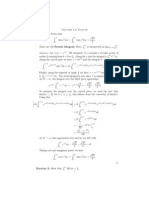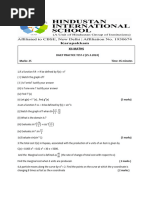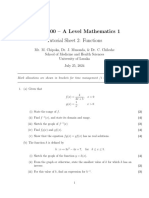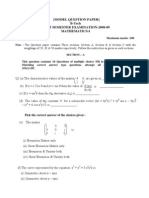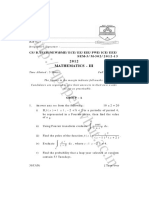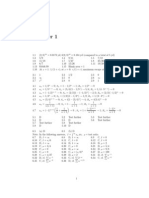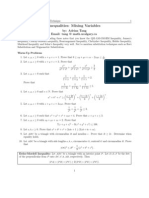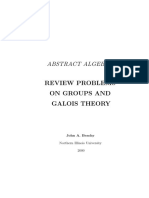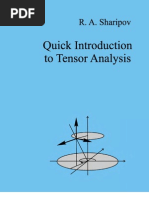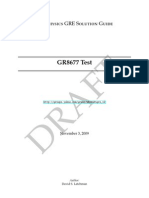Number Theory: Elliptic Curves (M4P32, M5P32), Problem Sheet 1
Number Theory: Elliptic Curves (M4P32, M5P32), Problem Sheet 1
Uploaded by
sticker592Copyright:
Available Formats
Number Theory: Elliptic Curves (M4P32, M5P32), Problem Sheet 1
Number Theory: Elliptic Curves (M4P32, M5P32), Problem Sheet 1
Uploaded by
sticker592Original Title
Copyright
Available Formats
Share this document
Did you find this document useful?
Is this content inappropriate?
Copyright:
Available Formats
Number Theory: Elliptic Curves (M4P32, M5P32), Problem Sheet 1
Number Theory: Elliptic Curves (M4P32, M5P32), Problem Sheet 1
Uploaded by
sticker592Copyright:
Available Formats
KMB, 14/10/10
Number Theory: Elliptic Curves (M4P32, M5P32), Problem Sheet 1
1) Let k be a eld, and x n 1. For i with 1 i n+1, let i : k n Pn (k ) be the maps (a1 , a2 , . . . , an ) [a1 : a2 : . . . : ai1 : 1 : ai : ai+1 : . . . : an ], as in lectures. a) Write down an injective map i : Pn1 (k ) Pn (k ) (make sure its welldened) with the property that Pn (k ) is the disjoint union of the images of i and i (hint: given [y1 : y2 : . . . : yn ] in Pn1 (k ), insert a zero in the appropriate place). b) Check that the union of i (k n ) for 1 i n + 1 is equal to all of Pn (k ). c) Find a point of Pn (k ) which isnt in i (k n ) for 1 i n. Can you nd another one? 2) For each of the polynomials f C[x, y ] below, work out all the singular points on the graph f = 0 in C2 (dont worry about points at innity). (i) f (x, y ) = y x2 (ii) f (x, y ) = y 2 x2 (iii) f (x, y ) = (3y 7x + 6)2 (iv) f (x, y ) = y 2 x3 (v) f (x, y ) = y 2 x2 (x + 1) (vi) f (x, y ) = y 2 x4 1 Now re-do part (vi) with the base eld equal to the eld with two elements. Note that the answer is quite dierent! 3) Back to K = C. Let f (x, y ) = y 2 x4 1 and let F (X, Y, Z ) denote its homogenisation. i) Check that P := [0 : 1 : 0] P2 (C) satises F (P ) = 0. ii) Check that P is a singular point on the curve F = 0. Hint: this is a point at innity, so one has to use a i other than 3 . Only one of the other two choices works; for this choice, dehomogenise and do the calculation in the corresponding ane space. 4) Let F k [X1 , X2 , . . . , Xn+1 ] be homogeneous and let f = F (x1 , x2 , . . . , xi1 , 1, xi , xi+1 , . . . , xn ) be a dehomogenisation of F . Assume f = 0. Let P An (k ) be a point on the graph f = 0 and let Q Pn (k ) denote i (P ). Prove that P is a singular point on f = 0 if and only if Q is a singular point on F = 0. Hence the two notions of singularity I gave in lectures coincide, when they both make sense. 5) Verify B ezouts theorem, to the extent that this is possible without a denition of multiplicity, for the following pairs of examples (let the ground eld be the complex numbers) i) f = x 2y , g = x2 y 2 ii) f = x y , g = x2 + y 2 iii) f = x y , g = x y 1 iv) f = y 2 x3 + 1, g = x 1
6) Use the draw a line through a known point trick, common sense and, if possible, factoring, to nd all rational a, b such that f (a, b) = 0, where f (x, y ) are the polynomials below: (i) f (x, y ) = x2 + xy + y 2 3 (hint: x = y = 1 is a solution) (ii) f (x, y ) = x2 + xy + 3x (iii) f (x, y ) = x2 + x + y 2 + 2y (hint: x = y = 0 is a solution) (iv) f (x, y ) = x2 + y 2 (v) f (x, y ) = x2 4xy + 4y 2 (vi) f (x, y ) = y 2 2x2 7) (i) Let g (x) be a polynomial in C[x]. Prove, by equating coecients of powers of y , that if the polynomial f (x, y ) = y 2 g (x) factors as f (x, y ) = (ay + p(x))(by + q (x)) with a, b C and p(x), q (x) C[x], then g (x) must be a square in C[x]. (ii) Prove that the polynomial y 2 x is a polynomial of degree 2 over C which does not factor over C into two polynomials of degree 1, even though C is algebraically closed. 8) I proved in lectures (or will prove in lectures, depending on when you are reading this) that if a conic has a singular point then it factors into two linear factors. Show that the corresponding result is false for polynomials of degree 3, by checking that f (x, y ) = y 2 x3 has a singular point but is an irreducible element of C[x, y ]. Hint: if it were to factor then consider, not the usual notion of degree, but the degrees of the factors when considered as polynomials over y only. Now use Q7.
You might also like
- Elementary Analysis SolutionsDocument68 pagesElementary Analysis SolutionsChance Zhang57% (46)
- Haykin, Xue-Neural Networks and Learning Machines 3ed SolnDocument103 pagesHaykin, Xue-Neural Networks and Learning Machines 3ed Solnsticker59256% (18)
- Grinstead, Snell Introduction To Probability Solutions ManualDocument45 pagesGrinstead, Snell Introduction To Probability Solutions Manualsticker592No ratings yet
- Manual AOAC Verified Methods ProgramDocument35 pagesManual AOAC Verified Methods Programsnrubics100% (1)
- Stein and Shak Arch I Complex Analysis So LNDocument52 pagesStein and Shak Arch I Complex Analysis So LNsticker592100% (8)
- Physics 1 - Problems With SolutionsDocument47 pagesPhysics 1 - Problems With SolutionsMichaelNo ratings yet
- Use Only: Introduction To Object-Oriented ProgrammingDocument16 pagesUse Only: Introduction To Object-Oriented Programmingsam100% (1)
- 3098 Mathcc5 L 3Document4 pages3098 Mathcc5 L 3neetmonthsNo ratings yet
- Tutorial Sheet 1Document3 pagesTutorial Sheet 1Ayush Kumar100% (1)
- Ass2019 Maths1 Single Variable PDFDocument2 pagesAss2019 Maths1 Single Variable PDFAnantaRajNo ratings yet
- Assignment I: (To Be Submitted in Tutorial Class by September 13, 2019)Document2 pagesAssignment I: (To Be Submitted in Tutorial Class by September 13, 2019)AnantaRajNo ratings yet
- Polynomials: 1 Roots of UnityDocument4 pagesPolynomials: 1 Roots of UnityFadil Habibi DanufaneNo ratings yet
- S Election Internationale 2010 Scientific Test: MathematicsDocument3 pagesS Election Internationale 2010 Scientific Test: MathematicsKlevis KasoNo ratings yet
- DPT2Document2 pagesDPT2sainimalsssNo ratings yet
- Midterm 16-17Document2 pagesMidterm 16-17api-253679034No ratings yet
- Training-Poly PutnamDocument13 pagesTraining-Poly Putnamtranhason1705No ratings yet
- 550-Spr2022-hw6 (1)Document3 pages550-Spr2022-hw6 (1)泓镇朱No ratings yet
- II PUC Mock Paper 2 MathematicsDocument4 pagesII PUC Mock Paper 2 MathematicsPandit Katti NarahariNo ratings yet
- JC1 HL 2017 09 13Document1 pageJC1 HL 2017 09 13Srivatsa RameshNo ratings yet
- As Cham 2002Document4 pagesAs Cham 2002Yon Seo YooNo ratings yet
- Bachelor of Science (B.SC.) Semester-V Examination Mathematics Optional Paper-1 (Analysis)Document2 pagesBachelor of Science (B.SC.) Semester-V Examination Mathematics Optional Paper-1 (Analysis)ajaysoni2097No ratings yet
- Paperia 2 2024Document11 pagesPaperia 2 2024TNo ratings yet
- Tarea 2 de Derivadas 2 PDFDocument6 pagesTarea 2 de Derivadas 2 PDFOscarDaniel Tello ChinguelNo ratings yet
- PMMT100 Tutorial Sheet 2Document5 pagesPMMT100 Tutorial Sheet 2Tadiwa DikanaNo ratings yet
- Model Paper MathematicsDocument5 pagesModel Paper Mathematicsamitkawasthi100% (1)
- 524.higher Mathematics ASSNGMET1Document5 pages524.higher Mathematics ASSNGMET1joseph.kabaso96No ratings yet
- assignmentDocument4 pagesassignmentManju SharmaNo ratings yet
- 1st Sem 2019 PHS (H) - CC-01-TDocument4 pages1st Sem 2019 PHS (H) - CC-01-TBoot BoxNo ratings yet
- Functions QuestionsDocument9 pagesFunctions QuestionsLucy MuthoniNo ratings yet
- 2751IIT MDocument4 pages2751IIT Mchandan yadavNo ratings yet
- Number Theory: Elliptic Curves, Problem Sheet 4Document2 pagesNumber Theory: Elliptic Curves, Problem Sheet 4sticker592No ratings yet
- TD1Document2 pagesTD1lilian58.lbNo ratings yet
- Winter School NotesDocument29 pagesWinter School Notesjgtml5550No ratings yet
- ISIDocument49 pagesISIShrihan SuchitNo ratings yet
- FN AssgnDocument3 pagesFN AssgnGarry GargNo ratings yet
- A Problem Set On Polynomials: Aditya GhoshDocument5 pagesA Problem Set On Polynomials: Aditya GhoshOm GuptaNo ratings yet
- ProbDocument10 pagesProbshihomasami140% (1)
- Complex I Draft 4Document36 pagesComplex I Draft 4Syed Hasan100% (1)
- 1092-Exam5 Uictkc6Document3 pages1092-Exam5 Uictkc6吳思翰No ratings yet
- FX X X: Assignment-IDocument3 pagesFX X X: Assignment-IluckydhruvNo ratings yet
- assignment16_1Document4 pagesassignment16_1kg2080bsNo ratings yet
- HSC Commerce 2014 October Maths1 PDFDocument2 pagesHSC Commerce 2014 October Maths1 PDFShradha Rohan BayasNo ratings yet
- Problems For MATH-4300 Complex VariablesDocument25 pagesProblems For MATH-4300 Complex VariablesYeshan JuberiNo ratings yet
- Mathematics 29.12.2024Document4 pagesMathematics 29.12.2024RANKANIDHI PRADHANNo ratings yet
- Qs 06Document3 pagesQs 06Jonel PagalilauanNo ratings yet
- Preliminary Exam 2016 Morning Exam (3 Hours)Document2 pagesPreliminary Exam 2016 Morning Exam (3 Hours)Atoloye Habeeb OlawaleNo ratings yet
- Mathematics1 MockWrittenExam 2020-21Document4 pagesMathematics1 MockWrittenExam 2020-21lelenathan100No ratings yet
- Hilbert ReviewDocument16 pagesHilbert ReviewGerman ChiappeNo ratings yet
- Limit - Sheet - 8: Level-1Document4 pagesLimit - Sheet - 8: Level-1Shivendra SinghNo ratings yet
- RevisionSheet6 TrigFunctionsDifferentiationDocument2 pagesRevisionSheet6 TrigFunctionsDifferentiationMario SaydeNo ratings yet
- HT TP: //qpa Pe R.W But .Ac .In: Mathematics - IiiDocument4 pagesHT TP: //qpa Pe R.W But .Ac .In: Mathematics - IiiSamaira Shahnoor ParvinNo ratings yet
- Mmc Paper 2024Document3 pagesMmc Paper 2024Chandan kumar MohantaNo ratings yet
- 06 HomeworkDocument4 pages06 Homeworknikaabesadze0No ratings yet
- List IaDocument34 pagesList IaTNo ratings yet
- CourseII 2016Document3 pagesCourseII 2016arvind lakshmi ranjanNo ratings yet
- STEP 2019 Paper3Document12 pagesSTEP 2019 Paper3Joydip SahaNo ratings yet
- 1011sem1 Ma2213Document4 pages1011sem1 Ma2213jlee970125No ratings yet
- Example Sheet 3, Galois Theory (Michaelmas 2022)Document2 pagesExample Sheet 3, Galois Theory (Michaelmas 2022)Aryan GadhaveNo ratings yet
- 2024 - SAT 1 - Mock TestDocument9 pages2024 - SAT 1 - Mock Testanp21299No ratings yet
- MAT1001 Midterm (2023)Document7 pagesMAT1001 Midterm (2023)Jessica AureliaNo ratings yet
- madhava 2022 qDocument1 pagemadhava 2022 qveena.tNo ratings yet
- MMC2022 SecondroundDocument1 pageMMC2022 SecondroundRahul MajgavakarNo ratings yet
- F.Y.B.SC (SEM. - II) 2019 PatternDocument89 pagesF.Y.B.SC (SEM. - II) 2019 Patterndotc701No ratings yet
- 2 1 function(学生版)Document3 pages2 1 function(学生版)1141515354No ratings yet
- ps4 99Document2 pagesps4 99sticker592No ratings yet
- Question Bank - AM - IIIDocument5 pagesQuestion Bank - AM - IIIYashi SinghNo ratings yet
- Boas - Mathematical Methods in The Physical Sciences 3ed Instructors SOLUTIONS MANUALDocument71 pagesBoas - Mathematical Methods in The Physical Sciences 3ed Instructors SOLUTIONS MANUALgmnagendra12355% (20)
- Neta Calculus of VariaionSolnDocument107 pagesNeta Calculus of VariaionSolnsticker592No ratings yet
- Adrian Tang - Mixing Variable TechniqueDocument4 pagesAdrian Tang - Mixing Variable TechniqueDijkschneier100% (4)
- Alder - An Introduction To Algebraic TopologyDocument142 pagesAlder - An Introduction To Algebraic Topologysticker592No ratings yet
- Ar Ve Son Spectral SolutionsDocument43 pagesAr Ve Son Spectral Solutionssticker592100% (1)
- Abstract Algebr Review Problem PDFDocument67 pagesAbstract Algebr Review Problem PDFhughng92No ratings yet
- (Tang C.) Solutions Manual. Fundamentals of OrgDocument65 pages(Tang C.) Solutions Manual. Fundamentals of OrgMehdi Torabi GoodarziNo ratings yet
- Sharipov-A Quick Introduction To Tensor AnalysisDocument47 pagesSharipov-A Quick Introduction To Tensor Analysissticker592100% (1)
- Baker-Algebra and Number TheoryDocument66 pagesBaker-Algebra and Number Theorysticker592No ratings yet
- Houston Complex AnalysisDocument98 pagesHouston Complex Analysissticker592No ratings yet
- GR8677 SolutionsDocument135 pagesGR8677 SolutionsDavid LatchmanNo ratings yet
- Effectiveness of Normalization Pre-Processing of Big Data To The Machine Learning PerformanceDocument6 pagesEffectiveness of Normalization Pre-Processing of Big Data To The Machine Learning Performancerefsen00No ratings yet
- HCL Shiv VlsiDocument12 pagesHCL Shiv VlsiRavi Teja MutyalaNo ratings yet
- ALP 50% DPQ NotificationDocument11 pagesALP 50% DPQ Notificationthaleshjoshi386No ratings yet
- Lesson planDocument18 pagesLesson planNaz Naz BaclidNo ratings yet
- Class 12 Maths CBSE Question Bank Oswaal Solved Papers PDFDocument252 pagesClass 12 Maths CBSE Question Bank Oswaal Solved Papers PDFcbse.pageNo ratings yet
- Residual Power Series Method For Obstacle Boundary Value ProblemsDocument5 pagesResidual Power Series Method For Obstacle Boundary Value ProblemsSayiqa JabeenNo ratings yet
- Mathematics Paper 3 Calculus HLDocument3 pagesMathematics Paper 3 Calculus HLJunehyung ChungNo ratings yet
- Types of Arrays in C RahulDocument10 pagesTypes of Arrays in C RahulBharath RajNo ratings yet
- Recoverable Reserve Estimation by Conditional SimulationDocument10 pagesRecoverable Reserve Estimation by Conditional SimulationKrishna DindaNo ratings yet
- Introduction To Classes: Fields DeclarationDocument19 pagesIntroduction To Classes: Fields DeclarationChintan Bhatt100% (1)
- 2019 3 Ked KtekDocument2 pages2019 3 Ked KtekMelody OngNo ratings yet
- Economic Dispatch 1Document76 pagesEconomic Dispatch 1RathinaKumar100% (1)
- Lesson PlansDocument8 pagesLesson Plansapi-416444696No ratings yet
- AM 1 Assig-IDocument2 pagesAM 1 Assig-ITanishq KaushikNo ratings yet
- Alice in Tara MinunilorDocument22 pagesAlice in Tara MinunilorKeith PopeNo ratings yet
- G8 PAG ASA Teachers GuideDocument4 pagesG8 PAG ASA Teachers GuideVhannie AcquiatanNo ratings yet
- Selina Concise Mathematics Class 9 ICSE Solutions for Chapter 1 - Rational and Irrational NumbersDocument57 pagesSelina Concise Mathematics Class 9 ICSE Solutions for Chapter 1 - Rational and Irrational Numbersbhuvanlg56No ratings yet
- Evs27 7430559Document9 pagesEvs27 7430559AzinoNo ratings yet
- Experiment: 1 Euclidean and Extended Euclidean AlgorithmDocument23 pagesExperiment: 1 Euclidean and Extended Euclidean AlgorithmWilliamNo ratings yet
- Soc 351-01 Chunyu FA 20Document14 pagesSoc 351-01 Chunyu FA 20abisagboolaoladotunNo ratings yet
- Measurement and Simulation of Grounding Resistance With Two and Four Mesh GridsDocument6 pagesMeasurement and Simulation of Grounding Resistance With Two and Four Mesh GridscphcricriNo ratings yet
- UNIT I of Automatic Control System (Dr. BAMU)Document70 pagesUNIT I of Automatic Control System (Dr. BAMU)Shantanu Gaikwad100% (1)
- G10 Math Q2 - Week 2 - 3 Proves Angles ArcsDocument20 pagesG10 Math Q2 - Week 2 - 3 Proves Angles ArcsOlive Botilo100% (1)
- Curved MirrorsDocument30 pagesCurved MirrorsSarahJeanPanuelosNo ratings yet
- Arrays in C: Example Where Arrays Are UsedDocument5 pagesArrays in C: Example Where Arrays Are UsedThe Indian MenNo ratings yet
- The Philosophy of Right and Left - Incongruent Counterparts and The Nature of Space (The Western Ontario Series in Philosophy of Science) (PDFDrive)Document370 pagesThe Philosophy of Right and Left - Incongruent Counterparts and The Nature of Space (The Western Ontario Series in Philosophy of Science) (PDFDrive)lukasNo ratings yet
- F2 Maths TopicalsDocument34 pagesF2 Maths Topicalswabwilehezron833No ratings yet
- Lab 1Document1 pageLab 1Jorge BerumenNo ratings yet




